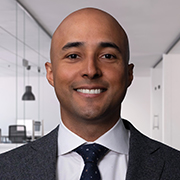ETFs: Past, Present & What's Next

Host: Peter Haynes, Managing Director and Head of Index and Market Structure Research, TD Securities
Guest: Andres Rincon, Director and Head of ETF Sales and Strategy, TD Securities
In this episode, we tackle what is arguably the greatest financial services innovation of the past 30 years. Join Peter Haynes and Andres Rincon as they discuss the ETF industry as we know it. Listen in to learn about the key drivers impacting ETF growth, unique events that have battle-tested the ETF structure, and whether the ETF market in Canada is truly oversaturated.
Listen to additional episodes for more perspectives from a variety of thought leaders on key themes influencing markets, industries and the global economy today.
[MUSIC PLAYING]
NARRATOR: Welcome to Viewpoint, a TD Securities podcast. Listen in as we draw perspectives from a variety of thought leaders on key themes influencing markets, industries, and the global economy today. We hope you enjoy this episode.
PETER HAYNES: Welcome to Viewpoint. My name is Peter Haynes, and I'll be your host for this episode, where we will discuss all things ETFs with our guest, Andres Rincon, head of ETF sales and strategy for TD Securities. Andres, thanks for joining us today.
ANDRES RINCON: Thank you for having me.
PETER HAYNES: So why don't we start by having you tell us a little bit about your background at TD. How long have you been involved in the TD Securities ETF initiative?
ANDRES RINCON: So I've been at TD roughly 15 years or so. I started on the rotational program, actually, with TD. Some people don't know this, but originally in risk. Then I transitioned into the derivatives world. So I worked in options for roughly a decade or so. In between, I've done a couple things.
So they sent me to London for, call it, five to six years, to grow the options business there. And then now there is an established business there, so I came back to Toronto. And in between, I've done a bit of cash equities. I worked with you in market structure. I transitioned to the ETF team in about five to six years. And as you said, I now lead the ETF sales and strategy efforts.
PETER HAYNES: One of the aspects, Andres, of your job is to publish a weekly research report on ETFs. And obviously, ETFs have grown a lot, even in the five years that you've been with this group. There's a school of thought that ETFs are, in fact, the greatest financial services innovation of the past 30 years. What do you think are the key drivers that are affecting the growth of ETFs?
ANDRES RINCON: We can talk about some of the key ones because there are really a lot of them. The way I would put it, one of the key drivers of growth is ease of execution, liquidity, transparency, and low cost, for Canada, mostly. In the US, you also have tax efficiency as a big factor for the growth of ETFs. So if we look in depth into some of these areas, like ease of execution, somebody can just pull up their machine and execute an ETF very easily.
Liquidity, the ETFs not just trade on the board, but also, at the end of the day, there's market makers behind it that can create and redeem an ETF. So there's two layers of liquidity for an ETF. And that's something that's been very beneficial across asset classes for ETFs and obviously very beneficial for the investor.
Low fees is the other one that's driven a lot of the growth. At the end of the day, one of the benefits of ETFs is it externalizes some of the costs for the investor because it actually is cheaper, in many cases, to buy a fund in ETF structure than in mutual fund structure per se. The last one I'll mention really quickly is speed of execution. Speed of execution is very important, especially in the institutional world. And that's an area that has become more and more common of why people are using ETFs in the institutional world.
PETER HAYNES: One of the aspects of this tremendous growth in the ETF product is actually proliferation has become so large that it has, in fact, made it difficult for investors and advisors to differentiate one ETF from another. By my count, there's over 2,800 ETFs in the US, with assets under management of 8.4 trillion, while there are another 1,277 ETFs in Canada today, with only 330 billion in AUM. Why does Canada have almost half the number of ETFs as the US, but less than 5% of the AUM? And is there something that can be done to slow down the proliferation of products, particularly north of the 49th parallel?
ANDRES RINCON: First thing I'll say is that I actually don't believe that the Canadian industry is saturated today. That is my opinion. But to answer your question on what can be done, I do believe that ETFs are self-regulating. To launch an ETF, it costs money. So when an issuer comes out and launches an ETF, it costs them, let's say, 50k, 75k. It also costs them listing on it. So they have ongoing costs.
On the other side, as a market maker, as we are, it costs us money to seed an ETF. It costs us money to hold inventory in ETF and to trade on an ETF. So on both sides of the equation, there are costs. So I believe, over time, as the number of ETFs grow, you're going to see a self-regulation as to what can be done on equilibrium in the space.
And we're seeing this already. Back at 2018, we had six new issuers that year. And over the last three years, we've only seen two or one. You can see it a little bit also this year in the slowdown of products. Obviously, last year was a record year for new products, but this year alone, we're, call it, less than half of what we had last year already. So we haven't seen as many products this year, for example, compared to the last few years.
The way I really like to look at it is twofold. I like to look at it by comparing AUM growth versus ETF product growth. So obviously, if the assets are growing and products are growing with it, then there's no real problem there, right? So in that space specifically, we have seen product growth stay in tandem with AUM growth. It's not that far off. And we do think the difference there is actually fairly healthy.
The other way we like to look at it is by population or by size of the listed market. If you look at population in the US, obviously it's considerably larger than Canada. So naturally speaking, that market should have more assets. But if you look at both population and change the market, like the US stock market is, call it, 14.8 times the size of the Canadian market, in terms of population it's about, call it, nine times. So the US ETF market is, call it, 9.3 times that of Canada. That's fairly in line with what it should be. So in our opinion, it's not really that saturated.
PETER HAYNES: So I know for the longest time, ETF issuers were afraid to be the first issuer to ever close down an ETF. Are you starting to see more fund managers that are just cutting bait on strategies that just clearly have not gained traction with investors?
ANDRES RINCON: 100%. We were looking at this stat this week, and how, over the last, I believe, two, three months, we've seen a lot of new launches, but I was surprised to see the number of ETFs decline by two. So we went back, and actually there's been, like, 20 new launches and 22 funds that have been delisted.
PETER HAYNES: Certainly, for those that are worried about there being too many products out there, it's encouraging to hear that things are slowing down and, in some cases, actually going the other direction. So the ETF product is over 30 years old, and most people would argue it's battle tested. Yet there always seems to be a naysayer out there that claims that the product will break under pressure. Has the ETF structure been properly battle tested, in your opinion?
ANDRES RINCON: Many, many times. So we have many times where it's happened-- in 2008 was a scenario where it happened. Obviously, there was extreme volatility across different asset classes. The most recent one where it's fresh in people's mind is the start of COVID, when you saw, especially in the fixed income space, a bit of a dislocation in NAV-- between the ETF price and NAV. And that time, you saw ETFs really show their true colors and how well they behaved in that time, for several reasons.
Number one, they were trading-- the market makers were there. And this is all despite the lack of ability to source the hedges, in some cases. The difference between NAV and the price of ETF actually is a true reflection of the ability to source the bonds in this specific scenario. And that really was a key moment for the ETF industry, to show that, despite this dislocation and the lack of liquidity, you could trade the ETF.
So yeah, many, many times. There's been, obviously, as you know, many articles that get written about this, but every single time, the ETF does what it's supposed to. And it's important to remind people that the ETF is simply a wrapper of the underlying basket, and it will always reflect the characteristics of the basket.
PETER HAYNES: So one of the things when we've seen dislocations that people want to talk about in what they think of as ETFs, it's actually not been ETFs that have had problems. It's been what are known as exchange-traded notes, ETNs, and other products where there is a decoupling due to some structural problem. Do you think that perhaps there needs to be a better job done by the industry to differentiate the ETF structure you referred to as the wrapper and these so-called notes that, from time to time, will decouple due to structural reasons?
ANDRES RINCON: Yeah, and I think the industry as a whole has already called for this to some degree. The average retail investor doesn't know the differences between the structures. We actually are in the process of writing a report just on this to make sure that people understand the differences because there are-- as you alluded to, there are consequences to having different structures, and there are pros and cons. And I think it's important for people to understand that. So yes, I think the industry should move in a way that these structures are highlighted and there's extra caution signs for some of these products.
PETER HAYNES: Yeah, we've heard about the lighting system, in terms of risk. That's one of the Bloomberg ideas. And I personally believe there should be some sort of differentiation and partitions put up in the market between these different types of products so that we can protect investors who may not fully understand what they're getting into. One of the catalysts for growth in ETFs-- and this is particularly in Canada-- has been what is known as active exchange-traded funds. What is unique about active ETFs, and why is this product type able to proliferate so much in Canada?
ANDRES RINCON: One of the interesting stats that people don't often think about is the number of active ETFs in Canada. So in Canada, we have-- about 21% of the ETFs in Canada, in terms of AUM, are in active land. If you talk to an active manager in Canada or in the US, they might not know this number is this big. They might still think that it's only passive world, right?
That's really interesting because, in Canada, we've seen a huge move that way. Obviously, unlike passive funds, they don't necessarily track an index. It's just like a mutual fund that trades on an exchange. So the manager has the ability to buy and sell more often, but at the end of the day, it's still an ETF, and it still is looking at an underlying basket.
In terms of what makes it really unique, what I would say, or why we got into this point is really, in my opinion, because of the progressive regulatory environment that we have here in Canada. Canada has a lot of firsts-- first fixed income ETF, first crypto ETF. A lot of this has been possible because of a more aggressive regulatory environment. That translates, in Canada, specifically, to Canada having a bit more lax rules on transparency and disclosure.
And that's what really has driven the growth of active ETFs in Canada. In Canada, you do not need to disclose your holdings on a daily basis, or you need to disclose every quarter, as any other mutual fund. And because of that, a lot of active managers are comfortable launching their ETFs with their secret sauce and not be really bothered about being forced to show their holdings on a daily basis, as you would in the United States.
PETER HAYNES: One of the concerns people would have with active ETFs, where there's less transparency, is that the price on the exchange that you pay-- and you referred earlier to NAV, Net Asset Value-- will be substantially different than the net asset value of the fund. Have you seen so far with active exchange-traded funds a lot of differentiation between the prices on the exchange and the actual net asset value of the fund?
ANDRES RINCON: No. I mean, not really. We get fairly up-to-date information from the funds, from the fund managers, too, as to what's in the fund. The ETF will track very closely what is in their underlying basket. In some cases, we actually have direct links with the PMs and know what's happening within the fund intraday, so we actually know what changes it to make to the valuation of the ETF that we're quoting on.
PETER HAYNES: Well, you mentioned fixed income ETFs a bit earlier, and I want to dig in on that. I was actually fortunate enough to start my career at the TSX, and I was involved in the launch of the first-ever ETF in 1990, on March 9, actually. It's a date I'll never forget. And it was called TIPS. And it was based on an equity index on the Toronto 35.
Canada and the TSX should be very proud of this accomplishment, given that we were the first to launch ETFs. But to me, an even more important achievement was the launch of fixed income ETFs in 2000, also on the Toronto Stock Exchange. What has the democratization of fixed income markets through the exchange-traded fund structure meant, and how do institutions and retail investors utilize fixed income ETFs?
ANDRES RINCON: For me, what it's meant is that it's told or signaled to the Street that ETFs are not just only for ultra-liquid listed securities. It's opened the door to many other products. Opened the door to futures-based products, commodities-based products, crypto, obviously, we have now. The white space has increased dramatically since that point. And I think that's one of the key benefits and one of the key catalysts that came after the fixed income ETF.
In terms of usage, there's many ways that both advisors and institutions use them, but the main ones really are, call it, tactical usage of ETFs. So they will come in and out of a position. That's mostly on the institutional side, of course, where we have interim beta usage, cash management using ETFs in a variety of different ways. On the advisor side, it tends to be more core positions, where I'm replacing this fund or this group of bonds with an ETF, and it's becoming a key part of the portfolio. Those are the two main ways that we see usage [INAUDIBLE].
PETER HAYNES: So as you look forward into the next chapter of the ETF journey, what are the potential catalysts for future growth? And are there any red flags that you're watching for that might serve as a warning to investors?
ANDRES RINCON: Why don't I start with the red flags? Those are some of the more interesting ones. Look, there's a lot happening in ETF world, as you know. There's a lot of new product. There's a lot of innovation in our space. And that's really, really exciting, but there's some that kind of fly very close to the sun, like two or three times leveraged ETFs, let's say.
Those are products that we have to be a bit careful about. And we discussed color signs or some ways to highlight that these funds are maybe a bit more risky than others or they need more work for investors to understand them. Currently, there isn't something along those lines. A lot of the dealers will have extra warning signs, but from a regulatory point of view, there isn't anything. And I think that's something that regulators need to look at, obviously. So that's one of them.
Non-transparent active ETFs in Canada is another area. It's not regulated, and it happens in Canada where you have an ETF that doesn't provide transparency to the market maker. There are some cases in Canada that does not exist in the US, but in Canada it does exist. That makes it very hard for market makers to quote on an ETF and know the true value of non-transparent active to the market maker, not just to the public. So that's another red flag that is not very popular, but it exists, and regulators haven't really commented on anything like that.
And the other thing I'll mention is super liquid underlyings. At the end of the day, an ETF trades throughout the day, so the underlying needs to trade throughout the day. You can't put real assets in an ETF, but people are trying. And that's an area that eventually-- or is becoming a concern for market makers.
In terms of areas of growth, really it's the MFDA channel. The MFDA channel, I think, if I can remember some of the stats, of the individuals that are actually allowed to talk to retail and advise them, about 85% of those advisors are in the MFDA channel.
PETER HAYNES: And to be clear, the MFDA channel is a channel of folks that aren't licensed to trade stocks. And because ETFs trade like stocks, we need some exemptions from regulators to allow those advisors to be able to use the ETF product. Is that correct?
ANDRES RINCON: That's correct. The MFDA channel, for the most part, they're not licensed to trade ETFs or buy stocks. They would have to be IIROC licensed. So that channel is fairly large. They look after, call it, 56% of Canadian households. It's a huge chunk. It's roughly $700 billion that the ETF role just doesn't really touch that much.
So there is some investment from those channels. Some of the MFDA houses have found a way to connect their advisors with ETFs. Some of them have gotten their IIROC license in their work. But it's far and few between, if I'm honest. And this is a huge opportunity for us. If you just take, call it, 10% of that and add it to ETF land, that's an increase of 20% of current AUM in ETF land. So that's a significant growth that we could see there.
And there is, most importantly, work being done today to get to that point. So just roughly about a year ago, IIROC, MFDA, and CSA together agreed to create a new SRO. And this new SRO would allow the MFDA channel to do this, to have access to ETFs, to recommend ETFs, so basically allow the retail investor to do this. So I think this is a huge opportunity for us. Obviously, it will take time, but it is something that we're looking forward to see more on that.
PETER HAYNES: I think it's an exciting development that the two regulators are merging and then will be under one umbrella. And that's certainly something that is being worked on as we speak, and hopefully done by the end of this year. Just as we wrap up the session here, I did want to finish off by asking you about another cool initiative you're involved with at TD Securities. Why don't you give our listeners a little preview of this project?
ANDRES RINCON: That's correct. I'm very excited about this. What we wanted to share is that we will be introducing a new monthly multi-format series to our audience that will feature our institutional clients and their perspectives on trends and conditions shaping global markets. The series will be called Buy Side Views. And given that we value our client relationships, we want to make sure we introduce our clients to all of our channels. We will take every opportunity, obviously, to highlight their knowledge across a variety of industries. So we look forward, obviously, to this series.
PETER HAYNES: Well, good luck with that project, and thanks a lot for joining us today.
ANDRES RINCON: Thank you.
NARRATOR: Thank you for listening to Viewpoint, a TD Securities podcast. If you enjoyed this episode, subscribe to this series on Apple Podcasts or on your favorite podcast platform. For more thought leadership content, visit TDSecurities.com and follow us on LinkedIn for all the latest TD Securities updates. For relevant disclaimers to this podcast, please refer to the Viewpoint episode page on--
This podcast should not be copied, distributed, published or reproduced, in whole or in part. The information contained in this recording was obtained from publicly available sources, has not been independently verified by TD Securities, may not be current, and TD Securities has no obligation to provide any updates or changes. All price references and market forecasts are as of the date of recording. The views and opinions expressed in this podcast are not necessarily those of TD Securities and may differ from the views and opinions of other departments or divisions of TD Securities and its affiliates. TD Securities is not providing any financial, economic, legal, accounting, or tax advice or recommendations in this podcast. The information contained in this podcast does not constitute investment advice or an offer to buy or sell securities or any other product and should not be relied upon to evaluate any potential transaction. Neither TD Securities nor any of its affiliates makes any representation or warranty, express or implied, as to the accuracy or completeness of the statements or any information contained in this podcast and any liability therefore (including in respect of direct, indirect or consequential loss or damage) is expressly disclaimed.

Peter Haynes
Managing Director and Head of Index and Market Structure Research, TD Securities

Peter Haynes
Managing Director and Head of Index and Market Structure Research, TD Securities

Peter Haynes
Managing Director and Head of Index and Market Structure Research, TD Securities
Peter joined TD Securities in June 1995 and currently leads our Index and Market Structure research team. He also manages some key institutional relationships across the trading floor and hosts two podcast series: one on market structure and one on geopolitics. He started his career at the Toronto Stock Exchange in its index and derivatives marketing department before moving to Credit Lyonnais in Montreal. Peter is a member of S&P’s U.S., Canadian and Global Index Advisory Panels, and spent four years on the Ontario Securities Commission’s Market Structure Advisory Committee.

Andres Rincon
Director and Head of ETF Sales and Strategy, TD Securities

Andres Rincon
Director and Head of ETF Sales and Strategy, TD Securities

Andres Rincon
Director and Head of ETF Sales and Strategy, TD Securities
Andres Rincon heads ETF sales and strategy at TD Securities. His ETF team advises both institutional and wealth investors on the ETF landscape and strategies, publishes a broad array of ETF publications, and works with TD's ETF market making team in facilitating ETF orders. Andres joined TD Securities in 2008, first managing credit risk for the dealer, and later as a member of the Equity Derivatives division. He later took on the task of expanding TD Securities' ETF sales and strategy platform. He is also a Chartered Market Technician (CMT).




